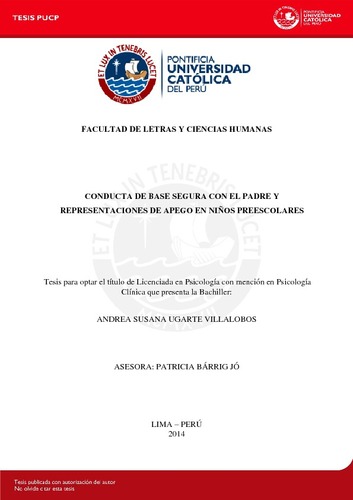| dc.contributor.advisor | Bárrig Jó, Patricia Susana | es_ES |
| dc.contributor.author | Ugarte Villalobos, Andrea Susana | es_ES |
| dc.date.accessioned | 2014-09-29T14:23:00Z | es_ES |
| dc.date.available | 2014-09-29T14:23:00Z | es_ES |
| dc.date.created | 2014 | es_ES |
| dc.date.issued | 2014-09-29 | es_ES |
| dc.identifier.uri | http://hdl.handle.net/20.500.12404/5599 | |
| dc.description.abstract | La presente investigación tiene como objetivo identificar la relación entre la conducta de base segura con el padre y las representaciones mentales de apego del niño. Para este propósito se evaluó a 18 niños con edades entre 48 y 68 meses (M = 58.5; DE = 6.6) junto a sus padres, con edades entre 25 y 50 años (M = 36.4; DE = 5.9), utilizando el Attachment Q-Set 3.0 (Waters, 1995) en modo observación para la conducta de base segura o seguridad global y el Attachment Story Completion Task (Bretherton, Ridgeway y Cassidy, 1990) para las representaciones de apego. Se encuentra una asociación positiva, alta y significativa entre ambos constructos, así como una relación positiva, grande y significativa entre las representaciones de apego y las escalas de Calidez en las interacciones, Búsqueda de proximidad y Placer en el contacto físico y no así con la escala de Interacción con otros adultos. Además, se tuvo como objetivo específico describir las representaciones, encontrando puntajes bajos y diferencias de acuerdo a la posición ordinal del niño. Respecto al segundo objetivo específico se describe la conducta de base segura, a partir de la comparación de los puntajes de observación con los criterios ideales propuestos por los expertos. En todos los casos, las puntuaciones de los participantes son significativamente inferiores, especialmente en la escala de Búsqueda de Proximidad y Placer en el contacto físico. Así mismo, la escala Calidez en las interacciones se encuentra más fuertemente asociada a la escala global de seguridad y los ítems más característicos resultan ser los de esta escala. Estos resultados señalan la importancia del vínculo de apego con el padre y dan luces acerca de los mecanismos subyacentes a la organización del apego en el aspecto representacional en la niñez. | es_ES |
| dc.description.abstract | This research aims to identify the relationship between secure base behavior with the father and attachment representations in children. In order to achieve this, 18 children between the ages of 48 and 68 months (M = 58.5, SD = 6.6) were evaluated, as well as their fathers, whose age varied between 25 and 50 years (M = 36.4, SD = 5.9). We used the Attachment Q-Set 3.0 (Waters, 1995) observation mode for secure base behavior or security and the Attachment Story Completion Task (Bretherton, Ridgeway and Cassidy, 1990) for attachment representations. The study found a strong, positive and statistically significant relation between the two constructs, as well as a positive and statistically significant correlation between the attachment representations and scales Smooth interactions, Proximity to father and Physical contact, whereas this was not found with the scale of Interactions with other adults. Additionally, the study had the specific objective of describing the attachment representations, finding low scores and differences in agreement in the ordinal position of the children. In respect of a second specific objective, we described the secure base behavior, from a comparison in observations points and the ideal criteria proposed by experts. In all cases, the participants’ scores were significantly inferior, particularly on the scale of Proximity to father and Physical contact. In addition, the scale Smooth interactions was more frequently associated with global security, and most characteristic items came from this scale. These results show the importance of attachment link bond with the father and shed light on the mechanisms underlying the organization of attachment in a representational aspect during childhood. | es_ES |
| dc.language.iso | spa | es_ES |
| dc.publisher | Pontificia Universidad Católica del Perú | es_ES |
| dc.rights | Atribución-NoComercial-SinDerivadas 2.5 Perú | * |
| dc.rights | info:eu-repo/semantics/openAccess | es_ES |
| dc.rights.uri | http://creativecommons.org/licenses/by-nc-nd/2.5/pe/ | * |
| dc.subject | Psicología infantil | es_ES |
| dc.subject | Apego. | es_ES |
| dc.subject | Conducta infantil. | es_ES |
| dc.title | Conducta de base segura con el padre y representaciones de apego en niños preescolares | es_ES |
| dc.type | info:eu-repo/semantics/bachelorThesis | es_ES |
| thesis.degree.name | Licenciado en Psicología Clínica | es_ES |
| thesis.degree.level | Título Profesional | es_ES |
| thesis.degree.grantor | Pontificia Universidad Católica del Perú. Facultad de Letras y Ciencias Humanas. | es_ES |
| thesis.degree.discipline | Psicología Clínica | es_ES |
| renati.advisor.dni | 09391905 | |
| renati.advisor.orcid | https://orcid.org/0000-0003-4685-5760 | es_ES |
| renati.discipline | 313026 | es_ES |
| renati.level | https://purl.org/pe-repo/renati/level#tituloProfesional | es_ES |
| renati.type | http://purl.org/pe-repo/renati/type#tesis | es_ES |
| dc.publisher.country | PE | es_ES |
| dc.subject.ocde | https://purl.org/pe-repo/ocde/ford#5.01.00 | es_ES |






